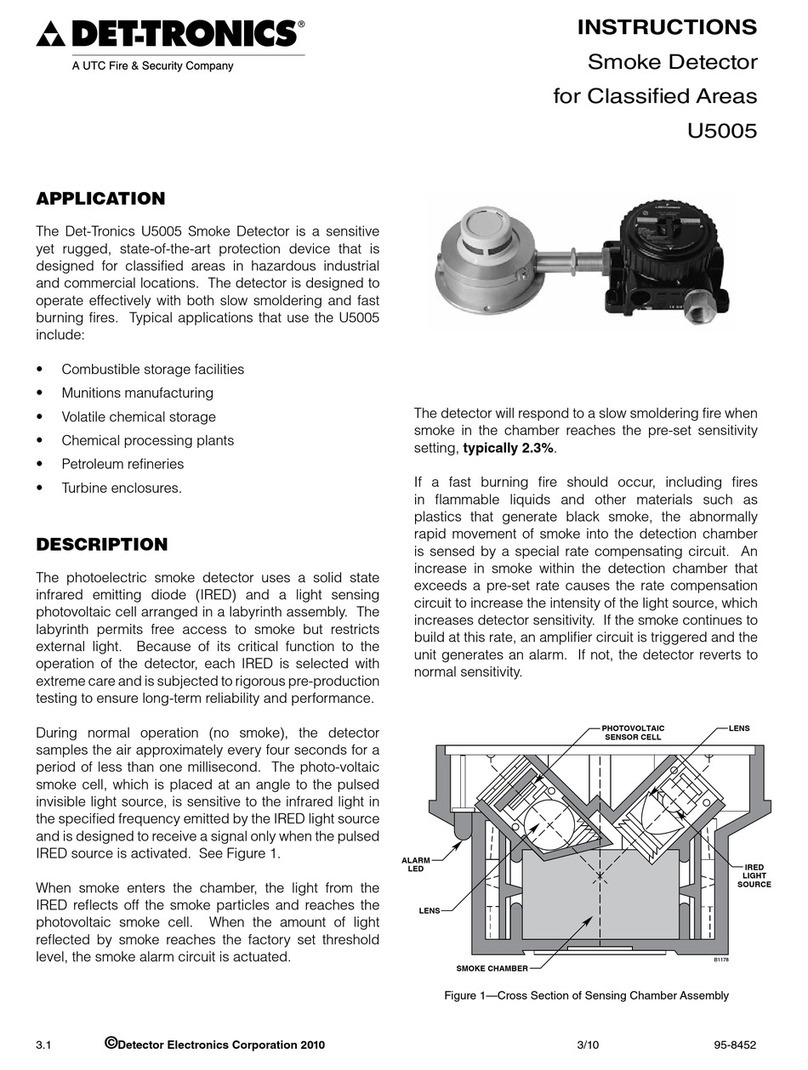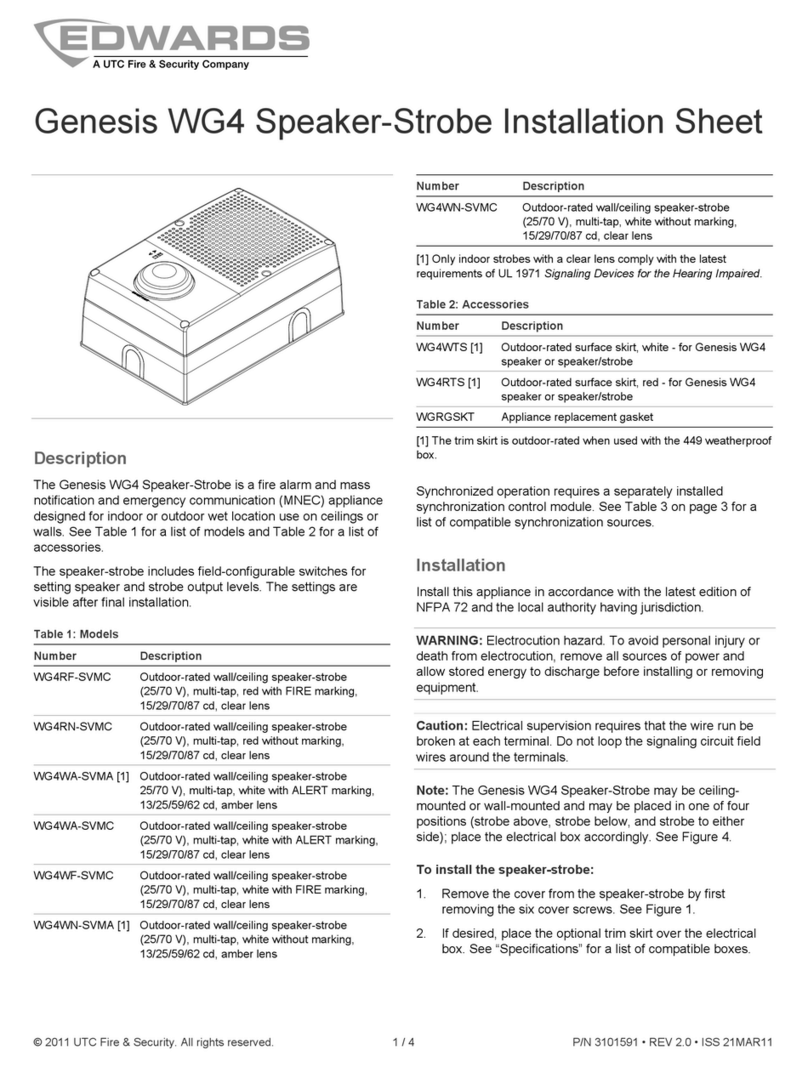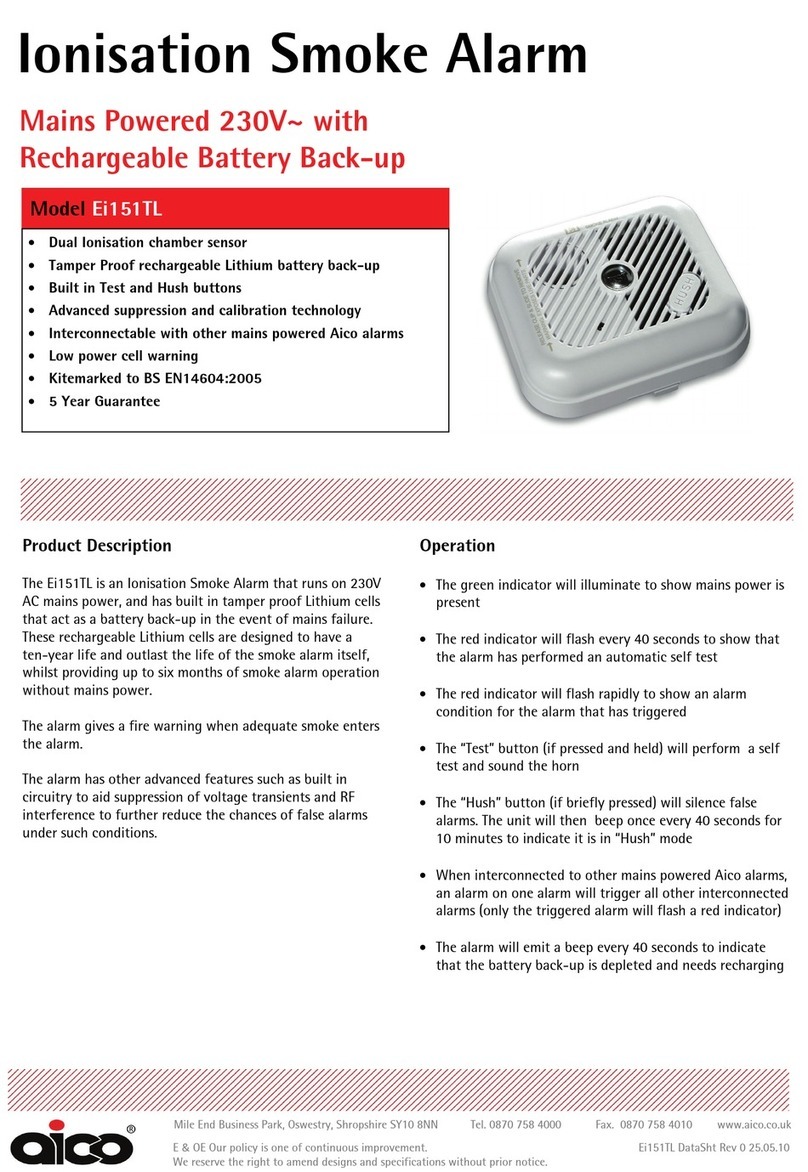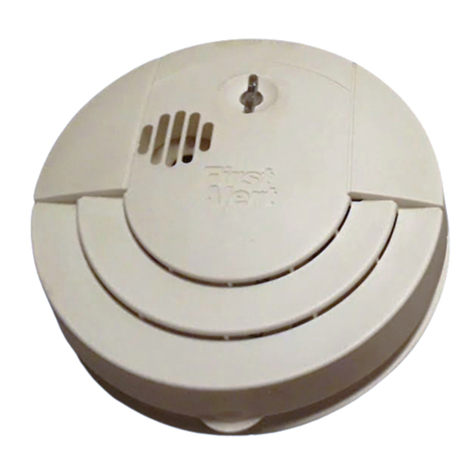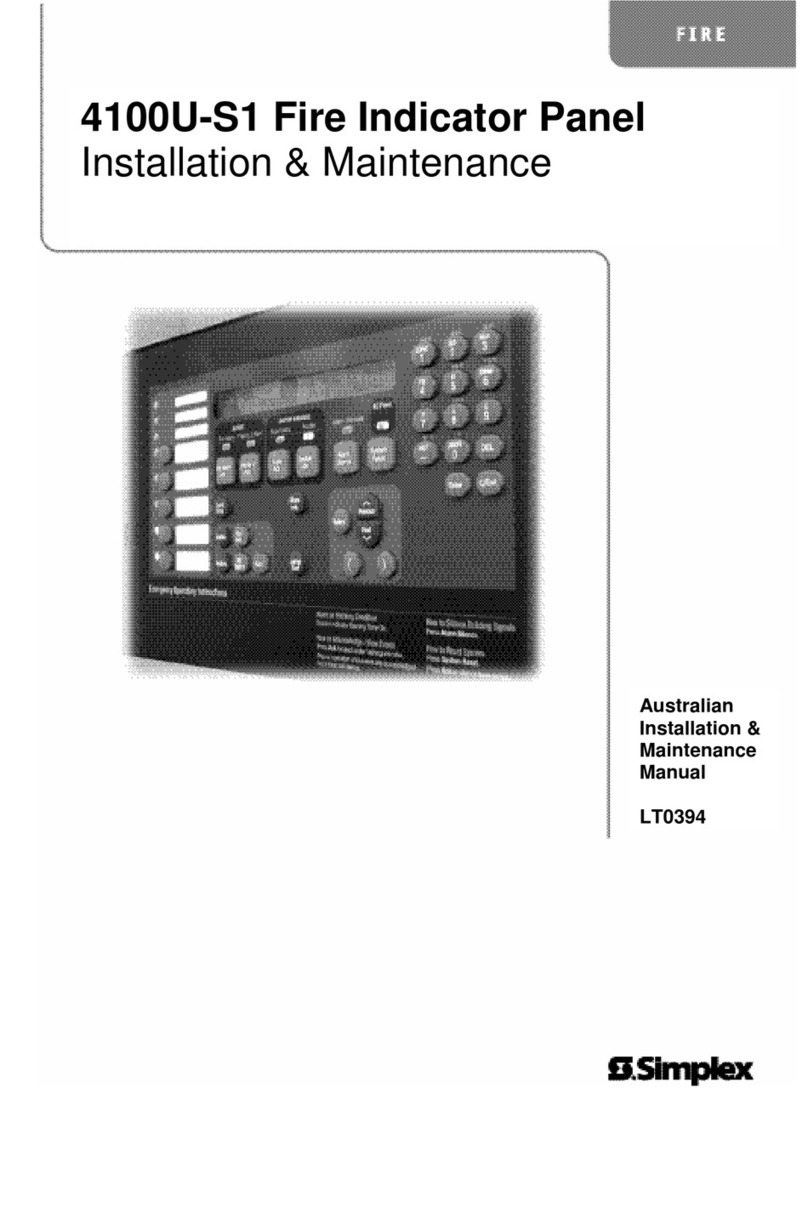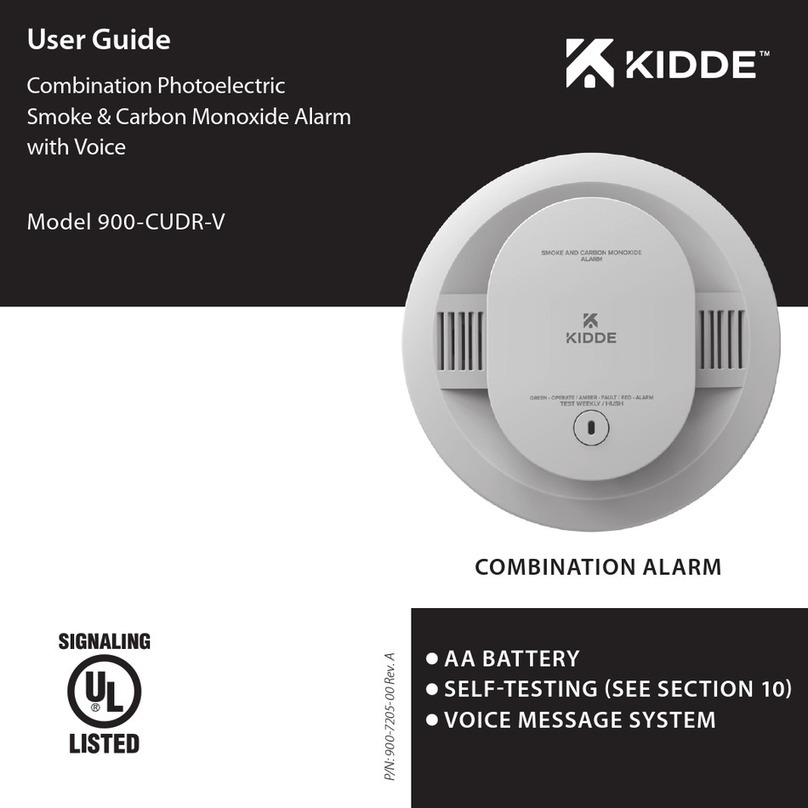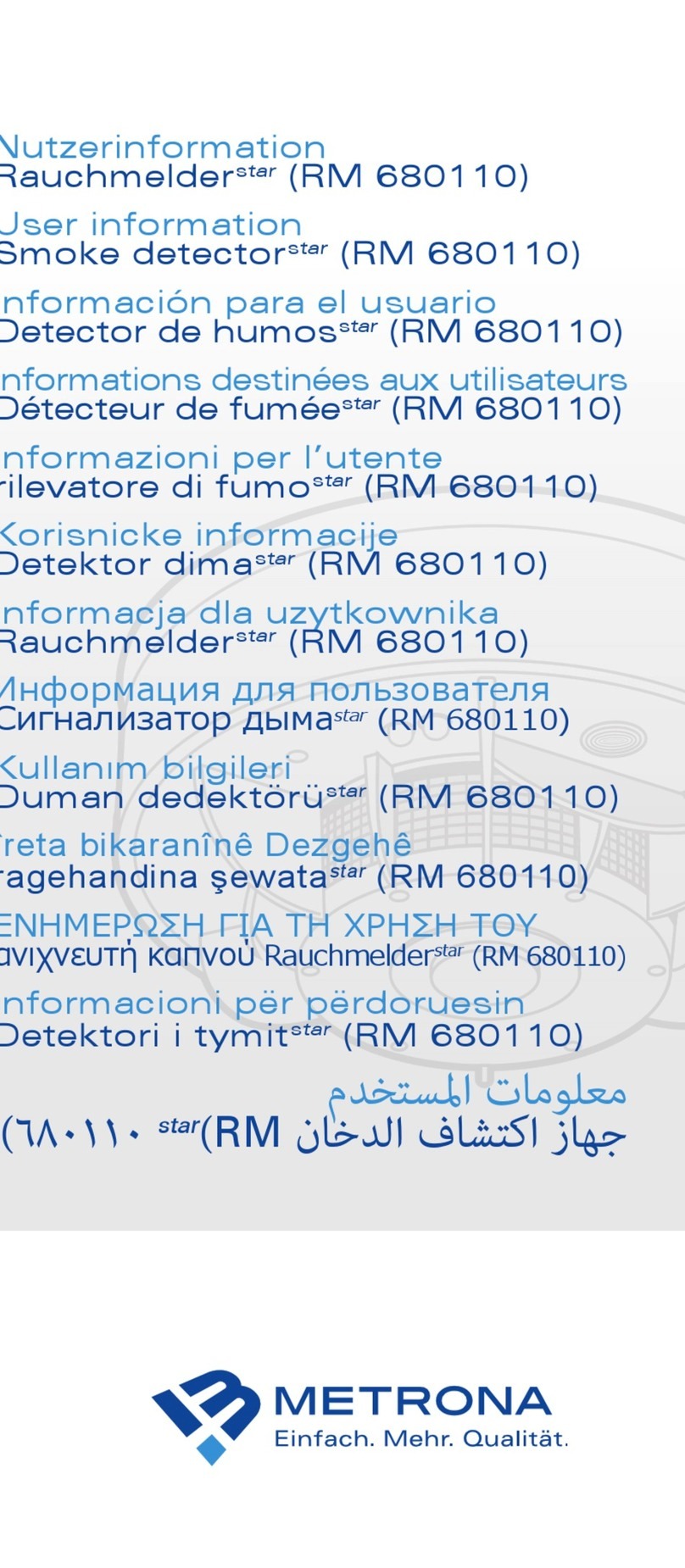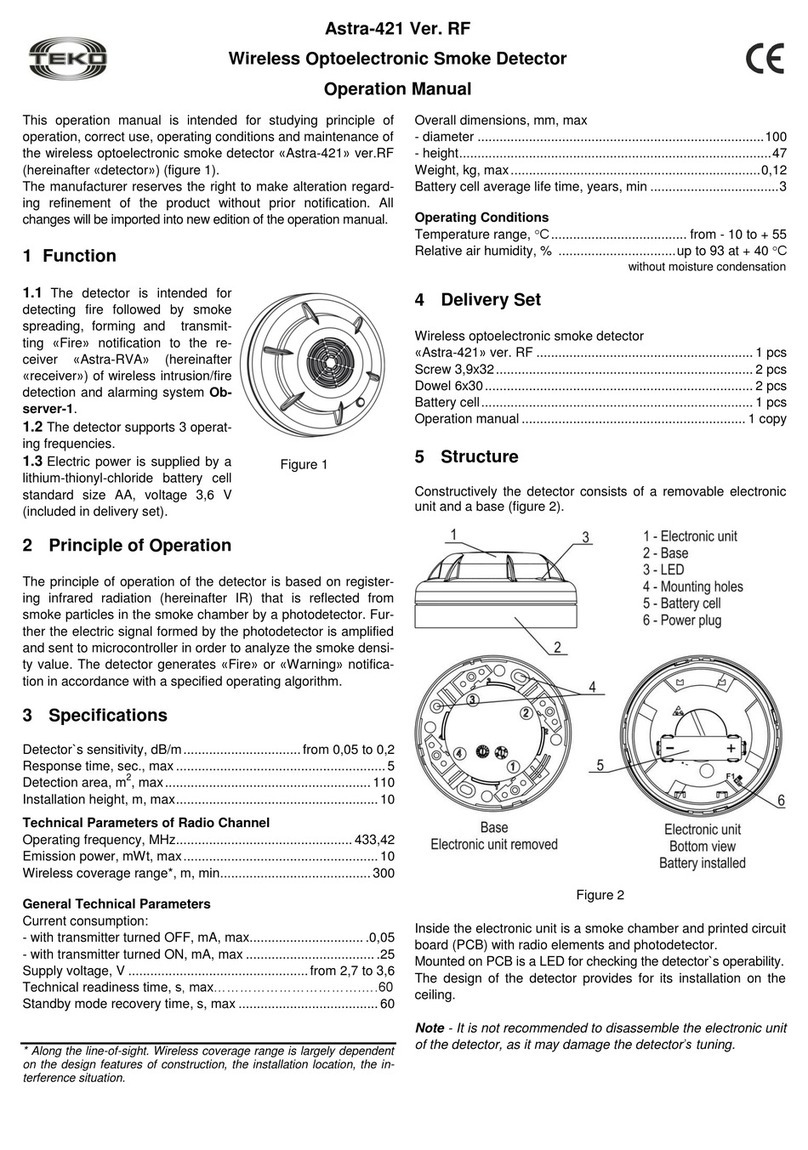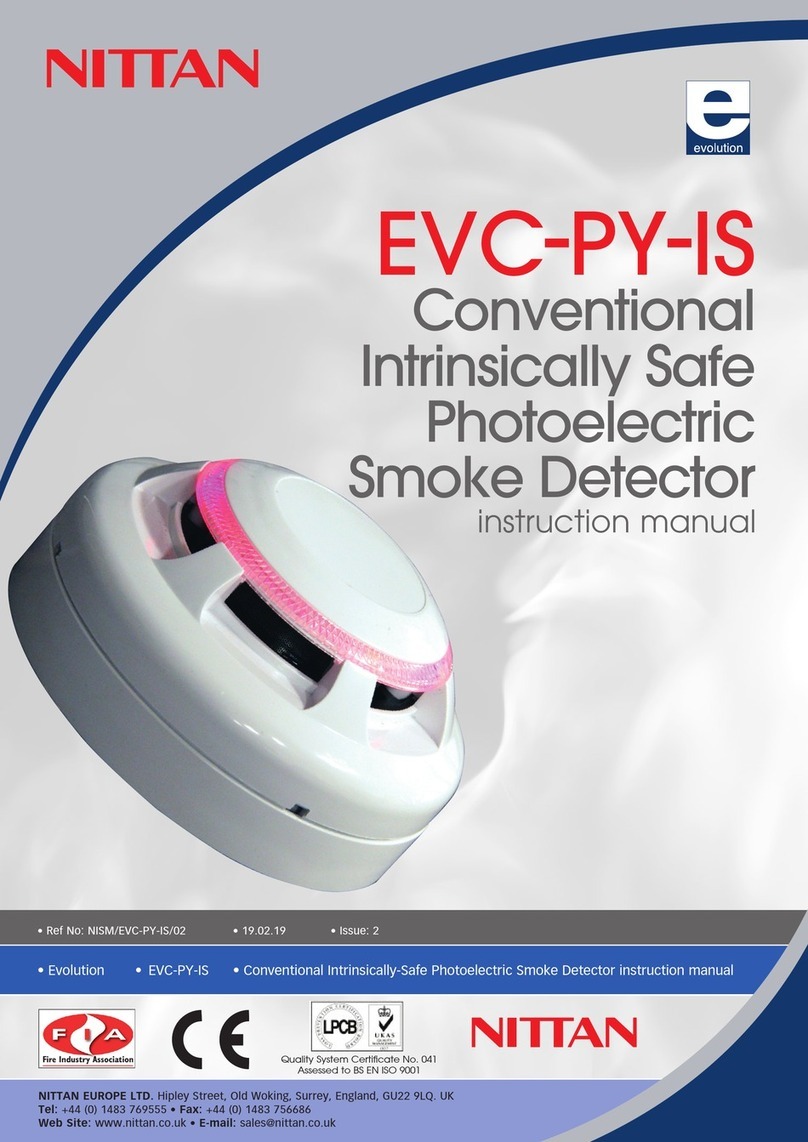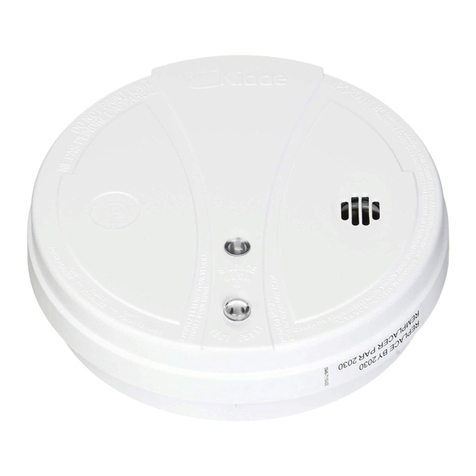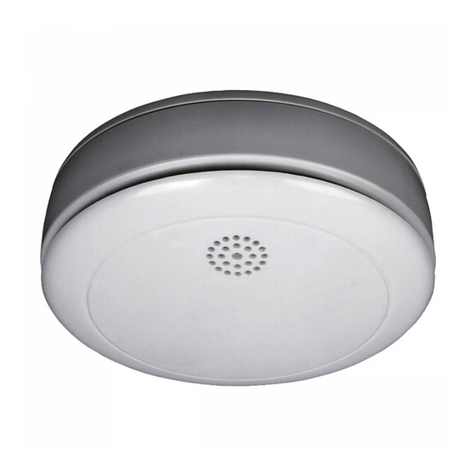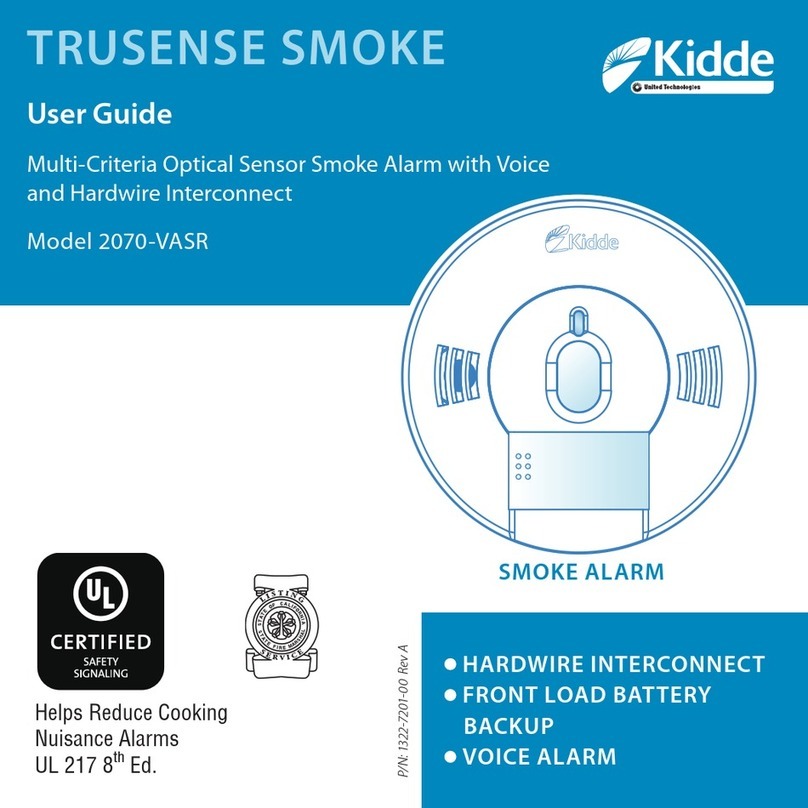UTC Fire and Security AirSense Stratos EX User manual

Stratos EX Hazardous
A
rea Aspirating Smoke
Detection System
Installation Manual
P/N 9-14519 • R02 • ISS 16APR12

Copyright © 2012 Kidde Products Ltd. All rights reserved.
Manufacture
r
Kidde Products Limited
Unit 2 Blair Way Dawdon
City: Seaham, County Durham
SR7 7PP
United Kingdom
Telephone: +44 (0)191-513 6100
Fax: +44 (0)191-513 6102
Certification
Contact information For contact information, see www.airsensetechnology.com.

Stratos EX Hazardous Area Aspirating Smoke Detection System Installation Manual i
Content
Important information ii
Chapter 1 Introduction 1
About this manual 2
Safety summary 2
Aspirating Smoke Detection System Limitations 4
Chapter 2 Product description 7
Introduction 8
Available software for the EX detector 9
Specifications 10
Features 11
Indicators 12
Outside the detector 13
Inside the detector 14
Detector connections 15
Chapter 3 Installation 17
Introduction 18
Antistatic precautions 18
Design 19
Installation 22
Interfacing 29
Configuring the EX detector after installation 32
Connecting to a PC 34
Event log 35
Chapter 4 Commissioning 37
Commissioning 38
Acclimation period 40
Suction pressure verification 41
Transport time verification 42
Gross smoke testing 42
Chapter 5 Troubleshooting 45
Troubleshooting 46
Chapter 6 Maintenance 49
Introduction 50
Maintenance 50
Appendix A Mounting template 57
Mounting template 58
Index 59

ii Stratos EX Hazardous Area Aspirating Smoke Detection System Installation Manual
Important information
Regulatory information
The EX detector series has been certified according to:
ATEX Directive 94/9/EC and the requirements laid down by the following
standards:
Standard Description
EN 60079.0: 2009 Explosive atmospheres equipment
General requirements
EN 60079-1: 2007 Electrical apparatus for potentially explosive
atmospheres
Flameproof enclosure ‘d’
Certificates
• ATEX Certificate: EPSILON 06 ATEX 2074 (EX detector)
• ATEX Certificate: EPSILON 06 ATEX 2138U (Flame Arrestor)
• ATEX Certificate: DEMKO 02 ATEX 131598 (GD-JB-8000 Flameproof
Enclosure)
Product identification label
Limitation of liability
To the maximum extent permitted by applicable law, in no event will Kidde
Products Ltd. be liable for any lost profits or business opportunities, loss of use,
business interruption, loss of data, or any other indirect, special, incidental, or
consequential damages under any theory of liability, whether based in contract,
tort, negligence, product liability, or otherwise. Because some jurisdictions do not
allow the exclusion or limitation of liability for consequential or incidental
damages the preceding limitation may not apply to you. In any event the total
liability of Kidde Products Ltd. shall not exceed the purchase price of the product.

Stratos EX Hazardous Area Aspirating Smoke Detection System Installation Manual iii
The foregoing limitation will apply to the maximum extent permitted by applicable
law, regardless of whether Kidde Products Ltd. has been advised of the
possibility of such damages and regardless of whether any remedy fails of its
essential purpose.
Installation in accordance with this manual, applicable codes, and the instructions
of the authority having jurisdiction is mandatory.
While every precaution has been taken during the preparation of this manual to
ensure the accuracy of its contents, Kidde Products Ltd. assumes no
responsibility for errors or omissions.
Advisory messages
Advisory messages alert you to conditions or practices that can cause unwanted
results. The advisory messages used in this document are shown and described
below.
WARNING: Warning messages advise you of hazards that could result in injury
or loss of life. They tell you which actions to take or to avoid in order to prevent
the injury or loss of life.
Caution: Caution messages advise you of possible equipment damage. They tell
you which actions to take or to avoid in order to prevent the damage.
Note: Note messages advise you of the possible loss of time or effort. They
describe how to avoid the loss. Notes are also used to point out important
information that you should read.
Product symbols
This symbol appears on the main board of the unit and indicates that the
board contains static sensitive components.
This label is located on the laser chamber at the bottom right of the open
detector and signifies that the unit is a Class 1 Laser product as specified
in IEC 60825-1. The unit incorporates a Class 3B embedded laser which
must not be removed from the detector, as retinal damage may result if
the laser beam enters the eye.
2002/96/EC (WEEE directive): Products marked with this symbol cannot
be disposed of as unsorted municipal waste in the European Union. For
proper recycling, return this product to your local supplier upon the
purchase of equivalent new equipment, or dispose of it at designated
collection points. For more information see: www.recyclethis.info.
This symbol indicates the safety ground studs. These are for grounding
cable screens, etc., and should not be connected to 0V or signal earth.


Stratos EX Hazardous Area Aspirating Smoke Detection System Installation Manual 1
Chapter 1
Introduction
Summary
This chapter provides information about this manual.
Content
About this manual 2
Safety summary 2
General safety notices 2
First aid 2
General precautions 3
Installation precautions 3
Aspirating Smoke Detection System Limitations 4

Chapter 1: Introduction
2 Stratos EX Hazardous Area Aspirating Smoke Detection System Installation Manual
About this manual
This manual is to be used by qualified and factory-trained personnel,
knowledgeable of all applicable standards in effect, and is intended to provide
guidance to qualified technical professionals for the installation, operation, testing
and maintenance of the EX Hazardous Area Aspirating Smoke Detection
System, referred to in this manual as the “EX” or the “detector.”
Only qualified persons experienced, trained and certified in the installation of this
equipment should design, service, maintain, test, install, and configure the EX
detector. They must be familiar and experienced with the wiring diagrams and
components, electrical installation, and familiar with local codes. The
manufacturer of the components that make up the EX detector is not responsible
for its configuration or for installation of the product.
It is the responsibility of the professional installer (described above) to properly
install, configure, and test the systems. Under no circumstances will the
manufacturer be liable for improper installation, maintenance, servicing, testing,
or configuration of the systems.
The technical data contained herein is provided for informational purposes only
and should not be used as a substitute for professional judgment and training.
Although the manufacturer believes this information to be true and correct, it is
published and presented without any guarantee or warranty whatsoever. The
manufacturer disclaims any liability for any use of the data other than as set out
in this manual, foreword included.
Safety summary
General safety notices
The following general safety notices supplement specific warnings and cautions
appearing in the manual. The safety precautions in this section must be
understood and applied during operation and maintenance. This manual is to be
used by trained distributors/technicians. The entire manual must be read and
fully understood prior to installation.
First aid
Any injury, no matter how slight, should never go unattended. Always obtain first
aid or medical attention immediately.

Chapter 1: Introduction
Stratos EX Hazardous Area Aspirating Smoke Detection System Installation Manual 3
General precautions
The following general safety precautions are to be observed at all times:
• All electrical components associated with equipment should be installed and
grounded in accordance with NEC and local regulatory requirements.
• Special precautionary measures are essential to prevent applying power to
equipment at any time maintenance work is in progress.
• Before working on electrical equipment, use a voltmeter to ensure that the
system is not energized.
• When working near electricity, do not use metal rulers, flashlights, metallic
pencils, or any other objects having exposed conductive material.
• When connecting a meter to terminals for measurement, use a voltage range
higher than the expected voltage to be measured.
Installation precautions
Adherence to the following will aid in problem-free installation with long-term
reliability.
Several different sources of power can be connected to this detector.
WARNING: Disconnect all sources of power before servicing. Control unit and
associated equipment may be damaged by servicing while the unit is energized.
Do not attempt to install, service, or operate this control unit until this manual is
read and understood.
Like all solid-state electronic devices, this system may operate erratically or can
be damaged when subjected to lightning induced transients. Although no system
is completely immune from lightning transients and interference, proper
grounding will reduce susceptibility.
Thise manual gives information likely to be needed for most installations, but for
more detailed information on subjects such as programming, networking, and
pipe networks, please refer to the SenseNET Software User Manual, Remote
Configuration Software Manual, and PipeCAD System Design and Installation
User Manual.
The label located on the laser chamber signifies that the unit is a Class 1 Laser
product as specified in IEC 60825-1. The unit incorporates a Class 3B embedded
laser which must not be removed from the detector as retinal damage may result
if the laser beam enters the eye.
WARNING: The use of overhead or outside aerial wiring is not recommended
due to the increased susceptibility to nearby lightning strikes. Consult with the
Technical Support department if any problems are anticipated or encountered.

Chapter 1: Introduction
4 Stratos EX Hazardous Area Aspirating Smoke Detection System Installation Manual
Do not install electronic assemblies prior to mounting and attaching conduit for
field wiring to the enclosure. Before making modifications, verify that they will not
interfere with battery and printed circuit board locations. Do not overtighten screw
terminals. Overtightening may damage threads, resulting in reduced terminal
contact pressure and difficulty with screw terminal removal.
This system contains static-sensitive components. Always ground yourself with a
proper wrist strap before handling any circuits so that static charges are removed
from the body. Use static suppressive packaging to protect electronic assemblies
removed from the control unit.
Follow the instructions in this manual. These instructions must be followed to
avoid damage to the control unit and associated equipment. System operation
and reliability depend upon proper installation.
Caution: While installing a fire alarm system may make lower insurance rates
possible, it is not a substitute for insurance. An automatic fire alarm system or
components of a system—smoke detectors, heat detectors, manual pull stations,
notification appliances, and a fire alarm control unit with remote-notification
capability—can provide early warning of a developing fire. Such a system,
however, does not assure protection against property damage or loss of life
resulting from a fire.
Aspirating smoke detection system
limitations
An aspirating smoke detection system—which can be made up of smoke
detectors, heat detectors, manual pull stations, notification appliances, and a fire
alarm control unit with remote-notification capability—can provide early warning
of a developing fire. Such a system, however, does not assure protection against
property damage or loss of life resulting from a fire.
Any fire alarm system may fail for a variety of reasons. The following are only
examples:
• Smoke detectors may not sense fire where smoke cannot reach the
detectors, such as in chimneys, in walls, on roofs, or on the other side of
closed doors.
• Smoke detectors on one level also may not sense a fire on another level or
floor of a building. A second floor detector, for example, may not sense a first
floor or basement fire.
• All types of smoke detectors—ionization, photoelectric and air aspirating—
have sensing limitations. No type of smoke detector can sense every kind of
fire caused by carelessness and safety hazards such as smoking in bed,
escaping gas, improper storage of flammable materials, overloaded electrical
circuits, or arson.

Chapter 1: Introduction
Stratos EX Hazardous Area Aspirating Smoke Detection System Installation Manual 5
• Notification appliances, such as bells, may not alert people if these
appliances are located on the other side of closed or partly open doors, or are
located on another floor of a building.
• A fire alarm system will not operate without electrical power. If AC power fails,
the system will operate from standby batteries only for a specified time.
• Auxiliary equipment used in the system may not be technically compatible
with the control unit. It is essential to use only equipment listed for service
with your control unit.
• Telephone lines needed to transmit alarm signals from a premises to a central
monitoring station may be out of service or temporarily disabled.
• The most common cause of fire alarm malfunctions is inadequate
maintenance. All devices and system wiring should be tested and maintained
by professional fire alarm installers following written procedures supplied with
each device. System inspection and testing should be scheduled monthly or
as required by national and/or local fire codes and standards. Adequate
written records of all inspections should be kept.

Chapter 1: Introduction
6 Stratos EX Hazardous Area Aspirating Smoke Detection System Installation Manual

Stratos EX Hazardous Area Aspirating Smoke Detection System Installation Manual 7
Chapter 2
Product description
Summary
This chapter provides descriptions of the detector features, specifications, and
controls and indicators.
Content
Introduction 8
Available software for the EX detector 9
Specifications 10
Recommended cable 11
Features 11
Indicators 12
Outside the detector 13
Inside the detector 14
Detector connections 15

Chapter 2: Product description
8 Stratos EX Hazardous Area Aspirating Smoke Detection System Installation Manual
Introduction
The EX detector is a highly sophisticated “next generation” high sensitivity
aspirating smoke detection product that provides all the benefits of air sampling
high sensitivity smoke detection, including very early warning. Designed for easy
installation and commissioning, the EX detector incorporates a patented “artificial
intelligence” known as ClassiFire, which allows the detector to configure itself to
optimum sensitivity, alarm thresholds, and minimum nuisance alarms for various
environments.
The EX detector operates by drawing air from a protected space via a supervised
piping network in relatively small areas. The sampled air is passed through a
“dust separator” to remove dust and dirt before entering the laser detection
chamber. Sophisticated, state of the art electronics are used to analyze the
sampled air and generate a signal representing the level of smoke present.
ClassiFire intelligence also monitors the detector chamber and dust separator
(filter) for contamination, continually adjusting the appropriate operating
parameters to counteract the negative effects of any contamination. Aspirating
smoke detectors are unique in being able to provide a consistent level of
protection in a very wide range of environments by continuously making minor
adjustments to sensitivity.
The aspirating line of detectors detects “difficult-to-detect” slow growth electrical
overload incipient fires in “difficult” environments.
This equipment is Class 111 as defined in EN 60950 (i.e., this equipment is
designed to operate from Safety Extra Low Voltages and does not generate any
hazardous voltages).
The EX detector is housed in a Groveley Engineering flameproof enclosure
(certificate No. DEMKO028TEX131598) which is fitted with Knitmesh flame
arrestors (certificate No. EPSILON06ATEX2138U) at the sample inlet and
exhaust ports. The detector features dual high pressure aspirators to overcome
the flow restriction of the Knitmesh flame arrestors and provide excellent air
sampling performance. The use of two aspirators provides an element of
redundancy as the system will continue to sample in the unlikely event of an
aspirator failure.
For ease of maintenance the air filter is mounted external to the main detector in
a separate stainless steel enclosure. The filter housing does not contain any
electrical equipment and so it can be opened for filter replacement without
compromising the flameproof protection of the system.
The light weight of EX detector (8.5kg) makes installation a simple and safe one-
man operation, with no special lifting equipment required.
The networking capabilities of EX detector permit the use of remote displays and
other standard accessories. Programming of an EX detector system can be
undertaken using the SenseNET system located in a safe area.

Chapter 2: Product description
Stratos EX Hazardous Area Aspirating Smoke Detection System Installation Manual 9
The EX detector is ATEX approved and is rated at EEx d IIB + H2 T3 (Tamb
-20°C to +45°C) or T2 (Tamb -20°C to +60°C).
The explanation of this rating is as follows:
E: Carries a certificate in accordance with European harmonised standards
Ex: Explosion-proof electrical equipment
d: Protected by a flameproof enclosure
II: Equipment class II (for surface industries)
B: Gas group B
+ H2: Hydrogen gas
T3: External surface temperature will never exceed 200°C.
This approval rating means that the system can be used in an area where an
explosive mixture is likely to occur in normal operation (Zone 1) and where the
gas which is causing the risk is from gas group A, gas group B, or is Hydrogen.
Explosion-proof housing
• Ex II 2 G EEx d IIB+H2 T3 (Tamb -20°C to 45°C)
• Ex II 2 G EEx d IIB+H2 T2 (Tamb -20°C to 60°C)
Key features
• Suitable for use with gas groups A, B, and Hydrogen.
• Light weight for easy and safe installation.
• The EX detector can easily be installed without any specialized tools or
software.
Available software for the EX detector
The Remote Configuration Software and the SenseNET software packages are
available for use with the EX detector.
• Remote Configuration Software: Provided free of charge with every
detector, this software package enables the user to set up and configure the
programmable functions of one or more detectors or command module from a
computer connected via an RS-232 serial cable.
Note: The EX detectors must be configured remotely using either the Remote
Configuration Software or SenseNET software, whereas an HSSD-2 detector
can be configured using its front panel keys and display.
• SenseNET software: This software is available for purchase from Kidde
Products Ltd. SenseNET software is used to configure and manage a large
network of detectors with a simple, streamlined graphical user interface from
a computer connected to a detector or command module via an RS-232 serial
cable to RS-485 converter interface.

Chapter 2: Product description
10 Stratos EX Hazardous Area Aspirating Smoke Detection System Installation Manual
Specifications
Caution: This equipment is only to be used in accordance with this specification.
Failure to operate the equipment as specified may cause damage to the unit,
injury, or property damage.
Table 1: Specifications
Specification Value
Supply Voltage 21.6 - 26.4 VDC
PSU Type: conforming to EN 54-4
Electrical safety complies with BS EN 610190-1
Explosion-proof housing Ex II 2 G EEx d IIB+H2 T3 (Tamb -20°C to 45°C)
Ex II 2 G EEx d IIB+H2 T2 (Tamb -20°C to 60°C)
Size (mm) excluding cable glands 400W x 200H x 180D inc. flame arrestors
Cable entries Up to 4 x M20
Weight 8.5kg
Housing material Aluminum LM25
Stainless Steel (ASTM 316) - option
Operating temperature range -10 to +60°C
Operating humidity range 0 - 90% noncondensing
Pollution degree 1
Installation category Category II
Sensitivity range (%Obs/m) Min = 25% Max = 0.03% FSD
Maximum sensitivity resolution 0.0015 % obs/m
Detection principle Laser light scattering mass detection
Particle sensitivity range 0.0003 µm to 10 µm
Current consumption 0.65 A
Relay contact rating[1] 10 VA (30 V max. or 0.5 A max.)
Maximum sampling pipe length 50 m
Sampling pipe inlets 1
Sampling pipe internal diameter 20 to 25mm
Alarm levels
4 (Fire 2, Fire 1, PreAlarm and Aux)
1 relay as standard, others available
Chamber service intervals Greater than 8 years (depending on environment)
Dust separator replacement intervals Greater than 2 years (depending on environment)
Programming PC via RS-232/RS-485
Data bus cable RS-485 data cable
Data bus length 1.2 km

Chapter 2: Product description
Stratos EX Hazardous Area Aspirating Smoke Detection System Installation Manual 11
Specification Value
IP rating IP50
SELV rating (EN 60950) Class III
[1]Devices, such as local sounders and beacons can demand high inrush currents, which may
damage the relays. If relays are used to drive the device directly, a suitable 47 Ωcurrent-limiting
resistor should be placed in series with the load.
Recommended cable
Specification Value
Section 1.5 mm²
Current rating 16.5 A
Resistance < 13.3 Ω/km
Impedance 115 Ω
Overall Diameter < 8.1 mm
Features
The following is a list of major features of the EX detector:
• Patented “artificial intelligence” known as ClassiFire (automatically learns
environment)
• Laser dust discrimination (LDD)
• Quick and easy installation
• Self-adjusting between the range of 0.4% and 2.0% obscuration
• Pre-engineered sampling pipe network designs

Chapter 2: Product description
12 Stratos EX Hazardous Area Aspirating Smoke Detection System Installation Manual
Indicators
Figure 1 below shows the three indicators on an EX detector.
Figure 1: EX Detector indicators
(1) Inlet
(2) OK: Illuminates to show normal operation when there are no faults. The OK lamp will flash
during the 15-minute FastLearn period when the detector is first learning about its
environment. Note: During initial setup, the OK LED will flash for 15 minutes while the
detector learns its operating environment. This does not indicate a problem with the detector.
(3) Fault: Illuminates when the unit has a fault and a fault signal is being sent to the fire alarm
panel or connected monitoring equipment.
(4) Fire: Illuminates when the alarm level has been reached and the appropriate time delays
have expired.
(5) Exhaust

Chapter 2: Product description
Stratos EX Hazardous Area Aspirating Smoke Detection System Installation Manual 13
Outside the detector
Figure 2 below shows external components on an EX detector.
WARNING: Removal of the detector screw down protective cover in most
applications where this product is installed will require a Hot Work permit.
Figure 2: EX external components
(1) Display retaining screws
(2) Lid locking set screw
(3) Screw down protective cover
(4) Inlet
(5) Cable glands
(6) Exhaust

Chapter 2: Product description
14 Stratos EX Hazardous Area Aspirating Smoke Detection System Installation Manual
Inside the detector
Figure 3
below shows the main interior parts of a detector with the cover off.
Figure 3: EX internal components
(1) Removable terminal blocks (See “Detector connections” on page 15.)
(2) Addressable Programmable Interface Card (APIC) connector (not currently supported)
(3) APIC securing pillars
(4) Detector address switch (See “Setting the device address” on page 29.)
(5) Detector assembly securing points x 4
(6) Display plate mounting pillar x 4
Table of contents
Other UTC Fire and Security Smoke Alarm manuals
Popular Smoke Alarm manuals by other brands

Ei Electronics
Ei Electronics Ei151TL User instruction

Hochiki
Hochiki SLR-24 installation instructions

BTR
BTR 60.300 Assembly, Installation and Commissioning Instructions
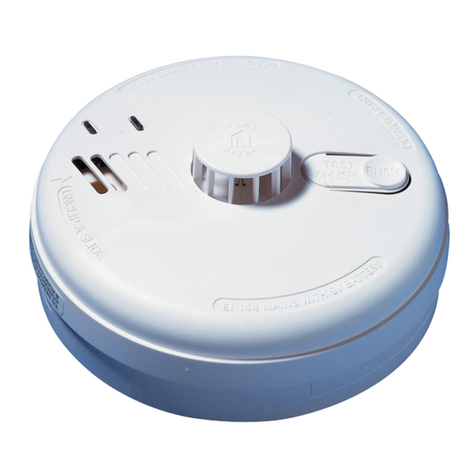
Ei Electronics
Ei Electronics Ei141 Ionisation installation instructions

SETRONIC VERONA
SETRONIC VERONA BOOMERANG 5P70 quick start guide

System Sensor
System Sensor PERTRONIC Innovair flex D4120 Installation and maintenance instructions
